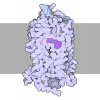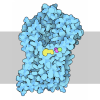 Yorodumi
Yorodumi- PDB-8v4s: Cryo-EM structure of the rat P2X7 receptor in the apo closed stat... -
+ Open data
Open data
- Basic information
Basic information
| Entry | Database: PDB / ID: 8v4s | |||||||||
|---|---|---|---|---|---|---|---|---|---|---|
| Title | Cryo-EM structure of the rat P2X7 receptor in the apo closed state purified in the absence of sodium | |||||||||
 Components Components | P2X purinoceptor 7 | |||||||||
 Keywords Keywords | MEMBRANE PROTEIN / Ion Channel / Ligand-gate Ion Channel / P2X Receptor / Allosteric Antagonist / High-Affinity Agonist | |||||||||
| Function / homology |  Function and homology information Function and homology informationThe NLRP3 inflammasome / regulation of presynaptic dense core granule exocytosis / Platelet homeostasis / positive regulation of lymphocyte apoptotic process / positive regulation of bleb assembly / NAD transport / phagolysosome assembly / Elevation of cytosolic Ca2+ levels / phospholipid transfer to membrane / positive regulation of cytoskeleton organization ...The NLRP3 inflammasome / regulation of presynaptic dense core granule exocytosis / Platelet homeostasis / positive regulation of lymphocyte apoptotic process / positive regulation of bleb assembly / NAD transport / phagolysosome assembly / Elevation of cytosolic Ca2+ levels / phospholipid transfer to membrane / positive regulation of cytoskeleton organization / purinergic nucleotide receptor activity / extracellularly ATP-gated monoatomic cation channel activity / lymphocyte apoptotic process / purinergic nucleotide receptor signaling pathway / positive regulation of monoatomic ion transmembrane transport / gamma-aminobutyric acid secretion / pore complex assembly / positive regulation of interleukin-1 alpha production / plasma membrane organization / positive regulation of gamma-aminobutyric acid secretion / negative regulation of cell volume / bleb / collagen metabolic process / plasma membrane phospholipid scrambling / ATP export / response to fluid shear stress / T cell apoptotic process / positive regulation of prostaglandin secretion / bleb assembly / mitochondrial depolarization / vesicle budding from membrane / ceramide biosynthetic process / positive regulation of T cell apoptotic process / programmed cell death / prostaglandin secretion / positive regulation of ossification / cellular response to dsRNA / cell volume homeostasis / glutamate secretion / positive regulation of glutamate secretion / negative regulation of bone resorption / skeletal system morphogenesis / phospholipid translocation / positive regulation of macrophage cytokine production / response to ATP / response to zinc ion / positive regulation of mitochondrial depolarization / positive regulation of calcium ion transport into cytosol / T cell homeostasis / synaptic vesicle exocytosis / monoatomic cation transport / membrane depolarization / membrane protein ectodomain proteolysis / : / protein secretion / negative regulation of MAPK cascade / neuronal action potential / positive regulation of bone mineralization / response to electrical stimulus / response to mechanical stimulus / regulation of sodium ion transport / T cell proliferation / homeostasis of number of cells within a tissue / extrinsic apoptotic signaling pathway / release of sequestered calcium ion into cytosol / sensory perception of pain / protein serine/threonine kinase activator activity / reactive oxygen species metabolic process / positive regulation of glycolytic process / positive regulation of interleukin-1 beta production / apoptotic signaling pathway / mitochondrion organization / positive regulation of protein secretion / establishment of localization in cell / response to bacterium / lipopolysaccharide binding / protein catabolic process / neuromuscular junction / T cell mediated cytotoxicity / terminal bouton / cell morphogenesis / : / protein processing / calcium ion transmembrane transport / response to calcium ion / positive regulation of T cell mediated cytotoxicity / positive regulation of interleukin-6 production / calcium ion transport / MAPK cascade / cell-cell junction / nuclear envelope / channel activity / signaling receptor activity / scaffold protein binding / gene expression / response to lipopolysaccharide / positive regulation of MAPK cascade / cell surface receptor signaling pathway / postsynapse / defense response to Gram-positive bacterium Similarity search - Function | |||||||||
| Biological species |  | |||||||||
| Method | ELECTRON MICROSCOPY / single particle reconstruction / cryo EM / Resolution: 2.49 Å | |||||||||
 Authors Authors | Oken, A.C. / Lisi, N.E. / Krishnamurthy, I. / McCarthy, A.E. / Godsey, M.H. / Glasfeld, A. / Mansoor, S.E. | |||||||||
| Funding support |  United States, 2items United States, 2items
| |||||||||
 Citation Citation |  Journal: Nat Commun / Year: 2024 Journal: Nat Commun / Year: 2024Title: High-affinity agonism at the P2X receptor is mediated by three residues outside the orthosteric pocket. Authors: Adam C Oken / Nicolas E Lisi / Ipsita Krishnamurthy / Alanna E McCarthy / Michael H Godsey / Arthur Glasfeld / Steven E Mansoor /  Abstract: P2X receptors are trimeric ATP-gated ion channels that activate diverse signaling cascades. Due to its role in apoptotic pathways, selective activation of P2X is a potential experimental tool and ...P2X receptors are trimeric ATP-gated ion channels that activate diverse signaling cascades. Due to its role in apoptotic pathways, selective activation of P2X is a potential experimental tool and therapeutic approach in cancer biology. However, mechanisms of high-affinity P2X activation have not been defined. We report high-resolution cryo-EM structures of wild-type rat P2X bound to the high-affinity agonist BzATP as well as significantly improved apo receptor structures in the presence and absence of sodium. Apo structures define molecular details of pore architecture and reveal how a partially hydrated Na ion interacts with the conductance pathway in the closed state. Structural, electrophysiological, and direct binding data of BzATP reveal that three residues just outside the orthosteric ATP-binding site are responsible for its high-affinity agonism. This work provides insights into high-affinity agonism for any P2X receptor and lays the groundwork for development of subtype-specific agonists applicable to cancer therapeutics. | |||||||||
| History |
|
- Structure visualization
Structure visualization
| Structure viewer | Molecule:  Molmil Molmil Jmol/JSmol Jmol/JSmol |
|---|
- Downloads & links
Downloads & links
- Download
Download
| PDBx/mmCIF format |  8v4s.cif.gz 8v4s.cif.gz | 349.9 KB | Display |  PDBx/mmCIF format PDBx/mmCIF format |
|---|---|---|---|---|
| PDB format |  pdb8v4s.ent.gz pdb8v4s.ent.gz | 283.4 KB | Display |  PDB format PDB format |
| PDBx/mmJSON format |  8v4s.json.gz 8v4s.json.gz | Tree view |  PDBx/mmJSON format PDBx/mmJSON format | |
| Others |  Other downloads Other downloads |
-Validation report
| Arichive directory |  https://data.pdbj.org/pub/pdb/validation_reports/v4/8v4s https://data.pdbj.org/pub/pdb/validation_reports/v4/8v4s ftp://data.pdbj.org/pub/pdb/validation_reports/v4/8v4s ftp://data.pdbj.org/pub/pdb/validation_reports/v4/8v4s | HTTPS FTP |
|---|
-Related structure data
| Related structure data |  42976MC  8tr5C  8trjC C: citing same article ( M: map data used to model this data |
|---|---|
| Similar structure data | Similarity search - Function & homology  F&H Search F&H Search |
- Links
Links
- Assembly
Assembly
| Deposited unit | 
|
|---|---|
| 1 |
|
- Components
Components
-Protein / Sugars , 2 types, 12 molecules ABC

| #1: Protein | Mass: 68472.461 Da / Num. of mol.: 3 Source method: isolated from a genetically manipulated source Source: (gene. exp.)   Homo sapiens (human) / References: UniProt: Q64663 Homo sapiens (human) / References: UniProt: Q64663 |
|---|---|
| #4: Sugar | ChemComp-NAG / |
-Non-polymers , 4 types, 255 molecules 






| #2: Chemical | |
|---|---|
| #3: Chemical | ChemComp-ZN / |
| #5: Chemical | ChemComp-PLM / |
| #6: Water | ChemComp-HOH / |
-Details
| Has ligand of interest | Y |
|---|---|
| Has protein modification | Y |
-Experimental details
-Experiment
| Experiment | Method: ELECTRON MICROSCOPY |
|---|---|
| EM experiment | Aggregation state: PARTICLE / 3D reconstruction method: single particle reconstruction |
- Sample preparation
Sample preparation
| Component | Name: Membrane protein / Type: COMPLEX / Entity ID: #1 / Source: RECOMBINANT |
|---|---|
| Source (natural) | Organism:  |
| Source (recombinant) | Organism:  Homo sapiens (human) / Cell: HEK293 GNTI- Homo sapiens (human) / Cell: HEK293 GNTI- |
| Buffer solution | pH: 7 |
| Specimen | Embedding applied: NO / Shadowing applied: NO / Staining applied: NO / Vitrification applied: YES |
| Vitrification | Instrument: FEI VITROBOT MARK IV / Cryogen name: ETHANE |
- Electron microscopy imaging
Electron microscopy imaging
| Experimental equipment |  Model: Titan Krios / Image courtesy: FEI Company |
|---|---|
| Microscopy | Model: FEI TITAN KRIOS |
| Electron gun | Electron source:  FIELD EMISSION GUN / Accelerating voltage: 300 kV / Illumination mode: FLOOD BEAM FIELD EMISSION GUN / Accelerating voltage: 300 kV / Illumination mode: FLOOD BEAM |
| Electron lens | Mode: BRIGHT FIELD / Nominal magnification: 130000 X / Nominal defocus max: 1400 nm / Nominal defocus min: 800 nm / Cs: 2.7 mm / C2 aperture diameter: 70 µm |
| Specimen holder | Specimen holder model: FEI TITAN KRIOS AUTOGRID HOLDER |
| Image recording | Electron dose: 45 e/Å2 / Film or detector model: GATAN K3 (6k x 4k) / Num. of real images: 11353 |
| EM imaging optics | Energyfilter slit width: 20 eV |
- Processing
Processing
| CTF correction | Type: PHASE FLIPPING AND AMPLITUDE CORRECTION |
|---|---|
| Symmetry | Point symmetry: C3 (3 fold cyclic) |
| 3D reconstruction | Resolution: 2.49 Å / Resolution method: FSC 0.143 CUT-OFF / Num. of particles: 273076 / Symmetry type: POINT |
 Movie
Movie Controller
Controller




 PDBj
PDBj








